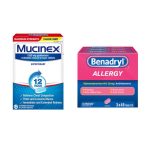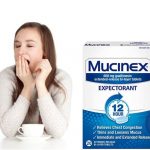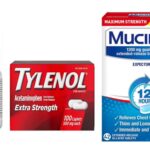Can Mucinex Cause Heavy Periods?

Menstruation is the shedding of the lining of the uterus (endometrium) accompanied by bleeding. It occurs in approximately monthly cycles throughout a woman’s reproductive life, except during pregnancy. Menstruation starts during puberty (at menarche) and stops permanently at menopause.
By definition, the menstrual cycle begins with the first day of bleeding, which is counted as day 1. The cycle ends just before the next menstrual period. Menstrual cycles normally range from about 25 to 36 days. Only 10 to 15% of women have cycles that are exactly 28 days. Also, in at least 20% of women, cycles are irregular. That is, they are longer or shorter than the normal range. Usually, the cycles vary the most and the intervals between periods are longest in the years immediately after menstruation starts (menarche) and before menopause.
Regular periods can vary. If your regular cycle is 28 days and you still have not had your period on day 29, your period is officially considered late. Likewise, if your regular cycle is 32 days and you still have not menstruated on day 33, this would be late for you. Missed or late periods happen for many reasons other than pregnancy. Common causes can range from hormonal imbalances to serious medical conditions. There are also two times in a woman’s life when it’s totally normal for her period to be irregular: when it first begins, and when menopause starts.
What is Mucinex?
Mucinex, a widely used over-the-counter medication, is primarily known for its effectiveness in alleviating symptoms associated with respiratory issues, such as congestion and excessive mucus production.
Mucinex contains the active ingredient guaifenesin, a medication commonly employed to alleviate chest congestion resulting from conditions like the common cold, flu, or chronic bronchitis. Guaifenesin is effective in reducing chest congestion by facilitating the loosening of mucus in the chest and throat, making it more manageable to expel through coughing.
While it’s an essential tool in managing colds and allergies, some people have raised concerns about its potential impact on menstrual cycles. In this article, we’ll explore the question: Can Mucinex cause heavy periods?
Understanding Mucinex
Before we delve into the potential link between Mucinex and heavy menstrual bleeding, let’s first understand what Mucinex is and how it works. Mucinex contains an active ingredient called guaifenesin, which acts as an expectorant. Its primary function is to thin mucus and make it easier to clear from the respiratory tract. It does this by increasing the volume and reducing the viscosity of mucus, which helps relieve congestion and other cold or allergy symptoms.
The Potential Link
The concern about Mucinex and heavy periods arises from the fact that guaifenesin can cause blood-thinning effects in some individuals. While this is typically not a pronounced effect, it has led to speculation that it might somehow affect the menstrual cycle. However, it’s crucial to note that there is limited scientific evidence to directly support the idea that Mucinex can cause heavy periods.
A study published in the Journal of the American Board of Family Medicine has provided valuable insights into the potential benefits of cervical dilation and cervical mucus thinning in the management of primary dysmenorrhea. Primary dysmenorrhea is a common condition characterized by painful menstrual cramps in the absence of any underlying medical conditions.
Studies have explored various methods for managing primary dysmenorrhea, and two aspects that have garnered attention are cervical dilation and cervical mucus thinning. These factors play a crucial role in the menstrual process and can potentially influence the severity of menstrual cramps.
- Cervical Dilation: Cervical dilation refers to the widening of the cervix, the narrow passage between the uterus and the vaginal canal. During menstruation, the cervix naturally dilates to allow the passage of menstrual blood. In some cases, women with primary dysmenorrhea may experience more significant cervical dilation, which can lead to more intense cramps. Understanding the mechanisms behind cervical dilation and how it relates to pain perception is an area of ongoing research.
- Cervical Mucus Thinning: Cervical mucus, also known as cervical fluid, changes in consistency throughout the menstrual cycle. Around the time of ovulation, cervical mucus typically becomes thinner and more slippery, allowing sperm to travel more easily through the cervix. Thicker cervical mucus can potentially impede this process. Some studies suggest that women with primary dysmenorrhea may experience alterations in cervical mucus consistency during their menstrual cycle, potentially contributing to pain.
It’s important to note that while these factors have been explored in the context of primary dysmenorrhea, the exact mechanisms and their relationship to pain are not fully understood. From a medical standpoint, the relationship between Mucinex and heavy menstrual bleeding is not well-established. Heavy periods, known as menorrhagia, can be caused by a variety of factors, including hormonal imbalances, uterine fibroids, polyps, and bleeding disorders. Guaifenesin, the active ingredient in Mucinex, is generally considered safe when used as directed for its intended purpose.
Individual Variability
People’s responses to medications can vary significantly, so it’s possible that a small number of individuals may experience changes in their menstrual cycles while taking Mucinex. However, these cases are likely to be exceptions rather than the rule. If you suspect that Mucinex is affecting your menstrual cycle, it’s essential to consult a healthcare professional to rule out any underlying medical issues and discuss alternative treatment options.
Conclusion
While there is no conclusive evidence to suggest that Mucinex directly causes heavy periods, it’s essential to understand that everyone’s body can react differently to medications. If you have concerns about the impact of Mucinex on your menstrual cycle, it’s best to consult with a healthcare provider. They can provide personalized advice and explore potential underlying causes of heavy periods, if any.
In most cases, using Mucinex as directed to alleviate respiratory symptoms is unlikely to lead to significant menstrual changes. However, for those experiencing unexplained changes in their menstrual cycles, professional medical guidance is the most reliable path to understanding and addressing the issue. READ: Accidentally Took Mucinex DM While Pregnant





